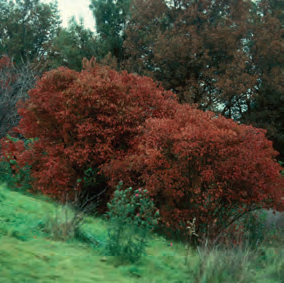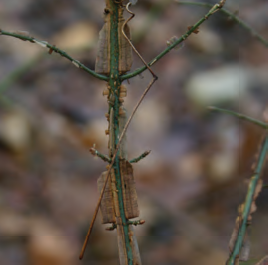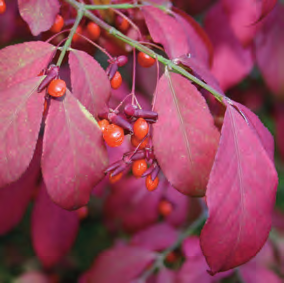Burning Bush,Wintercreeper
Euonymus alatus, Euonymus fortuneiBurning Bush
Bittersweet Family (Celastraceae)
Deciduous Shrub / Woody Vine
Flowers: Apr–Jun
Fruits: Sep–winter
Native Range: China, Korea, Japan
Introduction: 1860s as ornamental (E. alatus) 1907 as ground cover (E. fortunei)
Mid-Atlantic Range & Habitats: Burning Bush is found in forests, streambanks and hedgerows,mostly near heavily populated areas. Wintercreeper grows in disturbed forests, thickets, and floodplains, scattered in our region from NY and southeastern PA to VA.


Long planted as ornamentals, these species are relatively new invaders. The first populations of of Burning Bush (Euonymus alatus) invading natural areas were found in the 1960s and 1970s. This species tolerates heavy shade and forms dense shrub thickets in both disturbed and intact forest. The prolific fruit is eaten by birds, which disperse the seed to new locations. Wintercreeper (Euonymus fortunei) restricts native plant Burning Bush Flowerestablishment due to dense ground cover, and its vines reach 12–21 m high and can kill shrubs and trees supporting them.

Quick ID
| Burning Bush | Wintercreeper | |||
| Habit | Deciduous upright shrub | Evergreen sprawling or climbing vine with aerial rootlets | ||
| Stems | Stems winged | Stems not winged | ||
| Ripe Fruit | Capsule purplish | Capsule pale, whitish, becoming brownish with age | ||
More ID Tips
Strawberry Bush (E. americanus) can be distinguished by the combination of four-angled, wingless, green stems, five-parted flowers, pink fruits with bumpy surfaces, and orange arils. Wahoo (E. atropurpureus) has wingless stems, four-parted flowers and fruits, a smooth pink capsule, and red arils. Burning Bush (E. alatus) has winged stems, four-parted flowers and fruits, and distinctive purplish capsule segments that curl back on themselves after opening, leaving the red arils exposed. Wintercreeper (E. fortunei) has four-parted flowers and fruits, while Running Strawberry-bush (Euonymus obovatus) has five-parted flowers and fruits.


